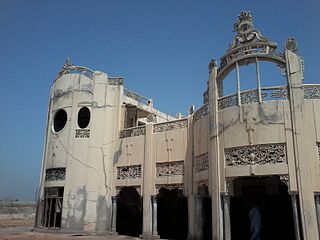
Khairpur District is a district in the Pakistani province of Sindh in Sukkur Division.

Barkhan is a district in the province of Balochistan in Pakistan. It shares its borders with the province of Punjab to the east and the Balochistan districts of Dera Bugti to the south, Kohlu to the west, Loralai to the northwest and Musakhel to the north. The town of Barkhan serves as the district's headquarters. It was granted the status of a separate district on 31 December 1991, prior to which it was a tehsil of Loralai District.
Buzdar is a clan of Baloch tribe of Rind, living in Balochistan, Sindh and Punjab provinces of Pakistan. They mostly live in the mountainous areas of Koh Suleiman.The estimated population of the tribe is 300,000 people. The word, literally meaning one who keeps or tends the goats, a shepherd, is a reference to the traditional occupation of Buzdars. Usman Buzdar is current Tumandar of the tribe.

Kashmore District, previously known as Khizmer or Khizmore, is a district of the province of Sindh, Pakistan. The capital city is Kandhkot. The district has a population of 1,090,336. Kashmore District is a part of Larkana Division. Its old name was Khizmer or Khizmor. The spoken languages are Sindhi and Balochi. Its border is connected with Punjab and Balochistan provinces. Kashmore city is gateway to Punjab province and Balochistan province. In 2004, Kashmore became a district after its separation from Jacobabad District.

Mirpur Khas District is one of the districts of Mirpur Khas Division in the province of Sindh, Pakistan. Its capital is Mirpur Khas city. District Mirpur Khas became district by separating from Tharparkar District on 31 October 1990. According to 2023 Pakistani census population of Mirpur Khas district is 1,680,980.

Mithi is a city and the administrative capital of Tharparkar District in the Sindh province of Pakistan. It became the district headquarter of Tharparkar District in 1990, after the area's separation from Mirpur Khas. Mithi is one of the very few cities in Pakistan where Hindus form a majority. Close to 80% of Mithi's population belongs to the Hindu community. Both Hindus and Muslims reportedly live peacefully and there have been no reports of religious intolerance.
According to the United States Energy Information Administration (EIA), Pakistan may have over 9 billion barrels (1.4×109 cubic metres) of petroleum oil and 105 trillion cubic feet (3.0 trillion cubic metres) in natural gas (including shale gas) reserves.

Mining in New Zealand began when the Māori quarried rock such as argillite in times prior to European colonisation. Mining by Europeans began in the latter half of the 19th century.

Mai Bakhtawar Airport located near Mithi and Islamkot in Tharparkar District, Sindh, Pakistan is named after Mai Bakhtawar Lashari. She was the first woman to lose her life during the peasant uprisings in Sindh in 1947.

Tharparkar, also known as Thar, is a district in Sindh province in Pakistan, headquartered at Mithi. Before Indian independence it was known as the Thar and Parkar (1901–1947) or Eastern Sindh Frontier District (1860–1901).
Mining is an important industry in Pakistan. Pakistan has deposits of several minerals including coal, copper, gold, chromite, mineral salt, bauxite and several other minerals. There are also a variety of precious and semi-precious minerals that are also mined. These include peridot, aquamarine, topaz, ruby, emerald, rare-earth minerals bastnaesite and xenotime, sphene, tourmaline, and many varieties and types of quartz.

The topography of Pakistan is divided into seven geographic areas: the northern highlands, the Indus River plain, the desert areas, the Pothohar Plateau, Balochistan Plateau, Salt Range, and the Sistan Basin. All the rivers of Pakistan, i.e. Sindh, Ravi River, Chenab River, Jhelum River, and Sutlej River, originate from the Himalayas mountain range. Some geographers designate Plateau as to the west of the imaginary southwest line; and the Indus Plain lies to the east of that line.
The Thar coalfield is located in Thar Desert, Tharparkar District of Sindh province in Pakistan. The deposits—16th-largest coal reserves in the world, were discovered in 1991 by Geological Survey of Pakistan (GSP) and the United States Agency for International Development.

The geology of Pakistan encompasses the varied landscapes that make up the land constituting modern-day Pakistan, which are a blend of its geological history, and its climate over the past few million years.
The Jhimpir Coal Mine is a coal mine located in Sindh. The mine has coal reserves amounting to 161 million tonnes of coking coal, one of the largest coal reserves in Asia and the world.
The Ongar Coal Mine is a coal mine located in Sindh. The mine has coal reserves amounting to 312 million tonnes of coking coal, one of the largest coal reserves in Asia and the world.
The Lakhra Coal Mine is a coal mine located in Sindh. The mine has coal reserves amounting to 1.33 billion tonnes of coking coal, one of the largest coal reserves in Pakistan.
The Sinhar Vikian Varvai Coal Mine is a coal mine located in Sindh. The mine has coal reserves amounting to 3.57 billion tonnes of coking coal, one of the largest coal reserves in Asia and the world.

The Engro Thar Coal Power Project (Thar-ll), also known as Engro Powergen Thar, is a coal-fired power plant developed as part of the China–Pakistan Economic Corridor by Sindh Engro Coal Mining Company and China Machinery Engineering Corporation in the Thar Block-II of the Thar Coalfield, Tharparkar District, Sindh, Pakistan 25 kilometers from the town of Islamkot near the village of Singharo-Bitra.

The Thari also known as the Dhatti are an Indo-Aryan ethno-linguistic group who reside in the Thar Desert, which is divided between Pakistan and India. They speak Thari, also known as Dhatki language. Thari is also a geographical term, it refers to anything which belong or come from Thar desert. The Thari people live primarily in Tharparkar district of Sindh in Pakistan. In India, Thari speakers are found in western parts of Rajasthan.











